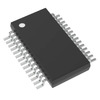Manufacturer Part Number
PIC16F15356T-E/SSVAO
Manufacturer
Microchip Technology
Introduction
The PIC16F15356 microcontroller is part of Microchip's PIC® 16F series designed for embedded applications.
Product Features and Performance
8-bit core processor
Core speed of 32MHz
Connectivity options include I2C, LINbus, SPI, UART/USART
Peripherals include Brown-out Detect/Reset, POR, PWM, WDT
25 I/O pins
Program Memory Size of 28KB (16K x 14)
FLASH Program Memory Type
RAM Size of 2K x 8
On-chip A/D 24x10b converters and a D/A 1x5b converter
Internal Oscillator
Product Advantages
Enhanced mid-range core with 49 Instruction, 16 Stack Levels
Flash Memory with self read/write capability
25 I/O pins with individual direction control
Highly configurable peripherals with independent interrupt-on-change
5-bit DAC with two output channels
Key Technical Parameters
Automotive Grade with AEC-Q100 qualification
Operating Temperature range from -40°C to 125°C
Supply Voltage range from 2.3V to 5.5V
Surface Mount 28-SSOP package
Quality and Safety Features
Extended operating temperature range suitable for automotive applications
Brown-out Detect/Reset ensures proper operation under low voltage conditions
Watchdog Timer (WDT) assists in maintaining proper operation by resetting the device in case of a software fault
Compatibility
Compatible with other devices in the PIC 16F series for scalable designs
Application Areas
Designed for use in automotive electronics
Suitable for industrial, consumer electronics, and embedded systems
Product Lifecycle
Product status is Active
Not currently indicated as nearing discontinuation
Several Key Reasons to Choose This Product
Highly integrated with extensive connectivity and peripheral options reducing external component count
Automotive qualification ensures reliability in demanding environments
Flexibility with programmable memory and digital-analog functionality accommodating diverse applications
High endurance Flash memory cells for extensive read/write cycles
Broad operating voltage range ensuring compatibility with various system power supplies
Support for multiple communication protocols increasing interfacing capabilities
Ample program memory and RAM for complex applications




 PIC16F15356-I/MLMicrochip TechnologyIC MCU 8BIT 28KB FLASH 28QFN
PIC16F15356-I/MLMicrochip TechnologyIC MCU 8BIT 28KB FLASH 28QFN